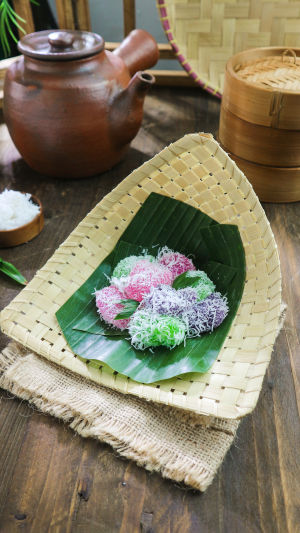If you're a fan of trying traditional sweets from around the world, then you need to add cenil to your dessert bucket list.
This vibrant and chewy Indonesian treat is more than just a sugary snack; it's a window into the country's rich culinary history and culture.
Found throughout Java and Bali, cenil has been a staple in local markets for generations, offering a burst of colors, textures, and flavors that reflect the heart and soul of Indonesia.
<h3>What Is Cenil?</h3>
Cenil is a traditional Indonesian dessert made primarily from tapioca starch or cassava flour, shaped into small, chewy pieces, and coated with grated coconut and sugar. The dessert is often brightly colored, making it an eye-catching treat at local markets or food stalls. The chewy texture is similar to that of mochi, but cenil has a distinct Southeast Asian twist due to the ingredients used and the way it's prepared.
The vibrant colors of cenil are not just for aesthetic purposes; in many regions of Indonesia, colorful food is considered festive and brings a sense of joy. While red, green, and yellow are the most common colors used, you can also find cenil in shades of blue or pink, all created using natural food dyes derived from plants like pandan leaves or butterfly pea flowers.
<h3>How Is Cenil Made?</h3>
Cenil's preparation is straightforward but requires precision. The base ingredient, tapioca or cassava starch, is mixed with water until a dough-like consistency is achieved. This dough is then shaped into small, bite-sized pieces, often cylindrical or spherical in shape, and sometimes rolled into strips or cut into squares. The pieces are then boiled until they become translucent and firm, giving them that signature chewiness.
Once the pieces are cooked, they are drained and tossed in freshly grated coconut, which adds a layer of texture and a subtle creaminess to the dessert. To finish, cenil is typically dusted with a generous amount of sugar, either white or palm sugar, adding a sweetness that balances the chewy texture and the coconut's natural richness.
RECIPE SWEET POTATOES CENIL‼️AN INDONESIAN SNACK‼️CENIL WITHOUT FOOD COLORING‼️
Video by MUTIARA CREATOR
<h3>Cultural Significance</h3>
Cenil is much more than just a dessert; it holds a special place in Indonesian culinary tradition. Historically, cenil has been a popular snack at traditional ceremonies and community gatherings. In rural parts of Java, it's often served during local festivals or family celebrations like weddings or baby showers, where food plays a crucial role in bringing people together. Sharing cenil at such events symbolizes warmth, hospitality, and the joy of communal eating.
Moreover, cenil is deeply rooted in Indonesia's street food culture. Vendors selling cenil are a common sight at local markets, particularly in the early mornings when locals gather to buy fresh produce and snacks for the day. The sight of vendors tossing cenil in coconut and sugar, while the vibrant colors pop against the natural hue of the coconut, is a nostalgic memory for many Indonesians.
<h3>Why You Should Try Cenil</h3>
Cenil is more than just a dessert—it's an experience. The combination of textures and flavors offers something for everyone. The chewiness of the tapioca, the creamy richness of the coconut, and the sweet finish of sugar create a perfect balance. Plus, it's a gluten-free and plant-based option, making it a great choice for those with dietary restrictions who still want to indulge in something sweet.
If you ever find yourself in Indonesia, seek out cenil at a local market, and you'll get a taste of tradition with every bite. It's a simple yet delightful way to connect with the culture, and it might just become one of your favorite desserts.
<h3>The Evolution of Cenil</h3>
Over time, cenil has evolved from a simple street food to a more refined dessert, with some restaurants and cafes offering modern variations. These variations may include gourmet versions using premium ingredients or fusion takes on the dessert, incorporating flavors like matcha, chocolate, or even tropical fruits like mango and pineapple.
Despite these modern twists, traditional cenil remains a beloved and staple food item, continuing to charm both locals and visitors alike with its unpretentious, joyful appearance and satisfying taste.
Cenil is a dessert that not only delights the senses but also tells a story of tradition, community, and celebration. Whether you're sampling it in a bustling Indonesian market or recreating it in your kitchen, cenil is sure to leave a lasting impression. It's a sweet, colorful reminder that sometimes, the simplest foods can bring the most joy.





